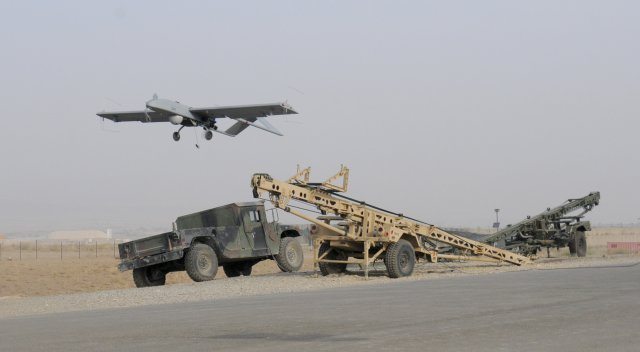“We have reports of the Afghan National Army sitting on an improvised explosive device at this location,” says a voice over the radio in a cramped control shelter Aug 25. “Can you give me an ETA?”
“Roger,” replies one of the unmanned aerial system, or UAS, operators listening in. “We’re 22 kilometers out. It’ll be 10 mikes.”
That conversation wouldn’t be out of place in a fast paced spy thriller. But for the UAS Platoon of Company B, Special Troops Battalion, 3rd Brigade Combat Team, 1st Infantry Division, Task Force Duke, a conversation such as this, between UAS operators and their crew chief, happens on a regular basis at Forward Operating Base Sharana.
The UAS Shadow is a remotely controlled aircraft with a camera attached that provides commanders with reconnaissance and surveillance without putting any Soldiers in harm’s way, said Chief Warrant Officer 2 Percell Hunter, the UAS platoon leader for Company B, STB.
In addition to its reconnaissance capabilities, the system can also point out targets to ground troops with a laser, and carry a communications relay package that allows two groups who are out of line-of-sight from each other to communicate, an ability of great importance in the mountains of eastern Afghanistan, where Task Force Duke is operating. It does this by flying between the two groups and bouncing the transmission from group one group to the Shadow to the other group, Hunter said.
“It [also] gives commanders a chance to see what they normally can’t,” said Staff Sgt. Michael Mikrut, the UAS platoon sergeant. “The UAS Shadow provides them with a situational awareness they would not normally have.”
Being part of the UAS crew means having to juggle a lot of different tasks. For that reason, operators have to be able to multitask, explained Sgt. Alex Keehn, a UAS operator with the Brigade Special Troops Battalion, 1st Brigade, 34th Infantry Division of the Minnesota National Guard.
“There is so much you have to be aware of when you fly a UAS,” Keehn said. “You have to be aware of wind speed, temperature, humidity and other aircraft in the area.”
Keehn’s unit deployed in July to augment the TF Duke UAS team, he said.
Communication plays a big part in the completion of successful UAS missions, said Sgt. Bill Parris, a UAS maintainer with Company B, STB.
UAS maintainers are responsible for performing maintenance and pre-flight checks on the aircraft, and help the operators when the UAS is airborne.
“You have to have situational awareness of air traffic or changes in wind speed because the UAS operators can’t see everything,” he explained.
For Parris, the conversation between operator and maintainer is like a ping pong game.
With helicopters and other aircraft using the same air space, the maintainer-operator conversation isn’t the only important one, said Mikrut.
“There are a lot of airspace communications,” Mikrut said. “Sometimes the airspace you are flying in gets taken away because another aircraft needs it more. You have to be quick to respond in those situations.”
To prepare for deployment, the UAS team undertook several flight operations training exercises, Hunter said. In these operations they endeavored to prepare their maintainers, who work on the aircraft, and operators, who fly the aircraft, to do their job without needing someone looking over their shoulder.
The training they received at their home-base of Fort Knox has benefited them in Afghanistan, Parris said. However, they have received several new soldiers, since arriving in country, who did not have the chance to train with the unit.
“It’s kind of a trial by fire [when new soldiers arrive during deployment,]” Parris said. “They just have to get in there and do it. While deployed they have plenty of opportunity to train and learn their job.”
The environment of eastern Afghanistan has many differences compared to Fort Knox that the crew has to be aware of when flying, Mikrut said. For starters, they are at an altitude of 7,300 feet and the air density is different than it would be at sea level, or even Fort Knox. This makes take-offs and landings more complicated.
Being aware of these differences is important and knowing what to do in any conditions can mean the difference between landing a bird safely or losing it, Mikrut said.










